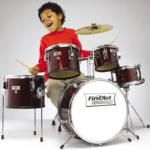As a parent, you probably wonder if starting violin lessons will be good for your child. You are probably thinking that it is too hard of an instrument for your child to learn. Although the violin is one of the harder instruments to learn here are some benefits that will help determine if you should start your child with the violin.
Recent studies have shown that the earlier music instruction is begun, the better. Starting violin training before the age of seven offers better results.
Physical Benefits:
- Strength and Flexibility in the upper body
- Arms and Fingers get stronger- The left hand’s fingers will gain nimbleness, also, because of quick movements as it presses down the strings of the violin. The right hand will learn to control the bow and coordinate its movements with the left hand.
- Posture improves- The posture will improve due to needing to sit up straight while playing.
Mind Benefits:
- Improved attention span and focus- Your child has to focus on learning both the violin itself and reading music.
- Sharpened Memory- Your child will need to start memorizing physical movements to make music, as well as how to read music.
- Improved self-discipline- To have the violin sound right, your child will need to practice a lot to improve skills.
- An Emotional Outlet- Playing the violin offers the opportunity to release your feelings.
- Reduced Stress- Lower levels of depression, anxiety, and other stress-related health problems. Playing the violin is a great stress reliever.
There are a lot of different musical styles for the violin. You can play traditional sounds of Middle Eastern, Asian, and Eastern cultures which are not possible on instruments like the guitar or the piano. Your child can learn to play rock, chamber music, pop, jazz, hip-hop, Americana, bluegrass, classical, baroque, romantic, modern, post-modern, Indian classical, folk, Arabic, Persian, klezmer.
Violins in Classical Music
Violins play a major role in classical music. There are different groupings of classical music where the violin and its family members are used:
- Symphony Orchestra- There are generally more violins than any other instrument in an orchestra. Orchestras have two sections of violins known as the first and second violins. They each play a different part. In a modern orchestra, there will usually be around 16 violinists in the violin I and 14 in violins II.
- Concerto- Concerto is when there is a solo instrument accompanied by an orchestra, typically the solo instrument will be a violin
- Chamber Ensemble- Chamber ensembles are smaller groups of instruments often featuring the violin.
- String Quartet- The string quartet is a popular grouping of musicians and instruments to play classical music. This group generally includes two violins, one viola, and a cello.
There’s really no perfect age to begin violin training, it’s more of a personal decision for you as a parent. If you want to get an idea if the violin will be too hard for your child or not, you should start introducing musical concepts and violin to see if your child has any interest at all.
Here are some questions to consider:
- Can he or she play cooperatively with you and others?
- Does your child pay attention when you’re explaining something?
- Are you ready for your child to start violin lessons, and will you assist with practice?
- Do you and your child have the time for lessons and daily practice?
The Violin Family-
- There are four main instruments in the violin family. The main difference for each of the different violins is the size of the instrument which affects the range of the notes they can play. The larger the instrument, the lower the range.
Here is the list from smallest to largest
- Violin- The smallest and the most popular of the family.
- Viola- Slightly larger than the violin, the viola has a lower pitch. It’s played in the same manner as the violin.
- Cello- The cello is quite a bit larger than the viola. Cello players sit down to play, resting the bottom of the cello, a metal spike, on the ground
- Double Bass- The double bass is the largest and lowest pitch member of the violin family. Musicians stand to play, with the bottom resting on the ground. The double bass is used to create a deep bass sound often used in folk music and jazz.
If you are interested in getting your child into violin lessons here in Omaha, NE, please give us a call at (402) 515- 9639 or visit us at OSMD. You can even stop by and get a tour we are located at 14505 California St Omaha, NE 68154.



